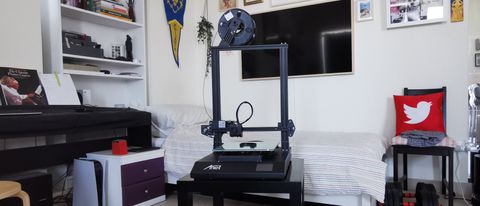TechRadar Verdict
The Anet ET5 Pro produces some great quality prints, and operates with very low noise levels. There are a few quirks that hold it back, but not enough to ruin your 3D-printing fun.
Pros
- +
Great print quality
- +
Quiet operation
Cons
- -
Bed leveling is still manual
- -
Occasional motor grinding
Why you can trust TechRadar
One-minute review
There’s an immense sense of satisfaction that comes with using the Anet ET5 Pro, one of the best 3D-printers for fuss-free creation (and one of our favorites). For starters, it’s much more quieter than previous models we’ve seen from the company. Second, it’s capable of printing some incredibly detailed things, often with truly mesmerizing results. A cute puppy? Check. A scale of the Titanic? Done. A 20-sided dice for a DnD session? No problem.
Truly, the limits of what the ET5 Pro can produce are bound to your imagination. From flexible snakes to adorable puppies and rocket ships – our test prints were all completed flawlessly, and we couldn’t wait to get started on our next project. The ET5 Pro takes a lot of the stress out of the assembly process as well, requiring about 20 minutes to assemble and wire everything together.
The crucial bed levelling process is still manual, and will require a great deal of patience to properly execute. Despite Anet saying that the ET5 Pro has automatic bed levelling, what they mean is that the printer will automatically check if your bed is truly level after you’ve manually adjusted it. It’s important that you do your manual bed levelling once you’ve assembled the printer, as there is a very real danger that the nozzle actually will press into the glass bed if you attempt a print without levelling first.
Price and availability
The Anet ET5 Pro is available directly from Anet’s website for $439.
Alternatively, you can also pick up the Anet ET5X directly from Amazon for around $289. The difference between the two models is that the ET5 Pro reviewed here is an upgraded version of the ET5X, with a silent motherboard installed for quieter printing.
Design
Wherever you order your ET5 Pro to, one thing you can be rest assured is that it will arrive safely. That’s because the packaging for this 3D printer is excellent, with every part snugly encased in packing foam to ensure that nothing is damaged in any way.
The printer itself comes in two major pieces – the first is the actual print bed with its own prebuilt assembly, and the second is a metal arm that connects perpendicularly to the bed and houses the print head mechanism.
The print head is also packed separately, and you get all the tools you need to put it all together, including screws, screwdriver, cable ties, allen keys, and of course an instructional manual. There’s also a matte print bed included in the box, which can be stuck on top of the glass bed in case you prefer this print surface instead.
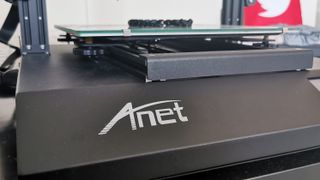
At the front of the printer you’ll find the main touchscreen interface, built right into the base. This is a great step up from previous Anet models that had the display attached via magnets.
Unique to the ET5 Pro is the sensor added to the print head. This essentially replaces the Z axis toggle that used to reside on the print arm, so now the sensor automatically detects when it’s close to the print bed. It’s also used when leveling the printer, but we’ll get to that in a bit.


On the left side you have a microSD card slot as well as a USB port for connecting the printer to your computer (a cable is not included). Lastly, you have the exposed connector board which plugs everything in and makes it all work. There’s sadly no cover for this, so we would advise you to be very careful with operating anything near this so that cables don’t accidentally get damaged or disconnected.
The ET5 Pro supports PLA filament, and there are a number of colors available through Anet’s website as well as third-party suppliers.
Setup and print quality
Assembling the ET5 Pro should take you about twenty minutes to accomplish. You simply hold the arm in place against the bed, twist in two bolts on each side, and then slide the print head on and connect all the cables. That’s by far your biggest hurdle, after which you can being your print bed leveling.
Getting your 3D prints looking perfect all depends on your bed level. If it’s too close to the print head, you’ll find stray bits of plastic being deposited as you print. Too far away, and your models will lack much of their definition and will turn out warped.



While the ET5 Pro talks of ‘auto bed leveling’, this means an entirely different thing. You would assume that with one tap your printer will automatically adjust all the tension knobs for the best print quality, and minutes later you can start printing. Sadly this is not the case – you’ll still have to manually adjust the print bed and print head in increments by yourself, and then use the auto leveling to double check that everything is actually in its proper place.
For anyone used to 3D printers, this will be fairly easy to go through, but if this is your first time then you’re going to want to take your time and make sure everything is leveled properly. Thankfully, Anet has an extensive guide on how to do this, and their support team is always ready to respond to user queries.



Once you’ve successfully leveled the printer and got it running, you can churn out your very first print. Anet has some basic models already on the included microSD card, but you can easily download almost any print from the Internet and scale it for the ET5 Pro using the included Cura software.
We were pleased at just how quiet the ET5 Pro is while printing, with the only real noise coming from the sound of the cooling fans. It’s much quieter than other models we’ve seen from the company, so you can easily leave this printing in the corner of a room and not be distracted by the noise.
The actual print quality is also very good, and will get incrementally better as you continue to tweak your print settings. We printed a variety of things with varying levels of detail including a puppy, replica of the Titanic, a icosahedron (20-sided dice), and a fully articulating snake.
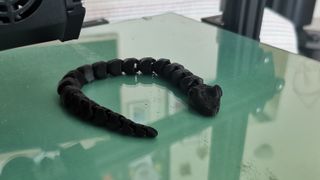
Another great feature of the ET5 Pro is how quickly both the print bed and the print head heat up. The print head can go from 35C to 200C in under two minutes, which is great so you don’t spend a lot of time waiting for your filament to heat up. The same applies for the print bed, which heats up to 60C for most prints in under a minute.
The printer also supports power outage recovery, so if the power fails, you can start printing from where you left off. This is a great feature to have, but we found that it also introduced some warped bits of filament to our models, simply because the printer had to reheat the extruded filament again in order to resume, which won’t come out evenly. There’s also automatic filament detection, so if the printer is running out of filament during a print, it will automatically alert you to insert some.

Each model came off the print bed perfectly, and the included puppy model was a great way to ensure that the printer was indeed properly calibrated before moving on to more detailed prints. Our one note would be that we prefer using the default glass print bed rather than the matte one – we found that models would more regularly stay attached to the matte surface and were difficult to remove cleanly, even with the removal tools that Anet includes.
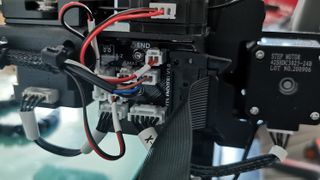
There were also some times where we experienced motor grinding with taller models, as if the printer was struggling to find the maximum height it could go to. The actual printable area is 30x30x40cm, and even when we printed a rocket model that was under these limits, we heard a bit of grinding on the motors. Hopefully this can be fixed with a possible firmware update, but if you’re not printing models that are very high, you’ll be fine.
Should I buy the Anet ET5 Pro?
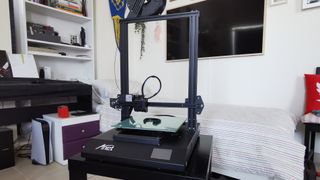
Buy it if…
You want an easy to assemble printer
The Anet ET5 Pro comes together in a short amount of time, and once setup can start churning out whatever you like.
You need a quiet printer
The fans on the Anet ET5 Pro are probably the loudest thing about it, so you can certainly have this printer in the same room while printing and not be disturbed.
Don’t buy it if…
You’re not patient
The most time-consuming part of the ET5 Pro is still levelling it properly, so if you’re looking for a true ‘unbox and print’ solution, this won’t be the one for you.
A former IT & Marketing Manager turned full time Editor, Nick enjoys reviewing PC components, 3D Printers, projectors, and anything shiny and expensive. He can also be found baking up a storm in the kitchen, which we are more than happy to encourage.

Apple is reportedly developing its own AI servers — could it be gearing up to take on Nvidia and AMD?

This Game Boy-styled MagSafe stand just tickled my retro-gaming synapse – now all I need is a matching controller for Nintendo emulators

AI Explorer could revolutionize Windows 11, but can your PC run it? Here's how to check
